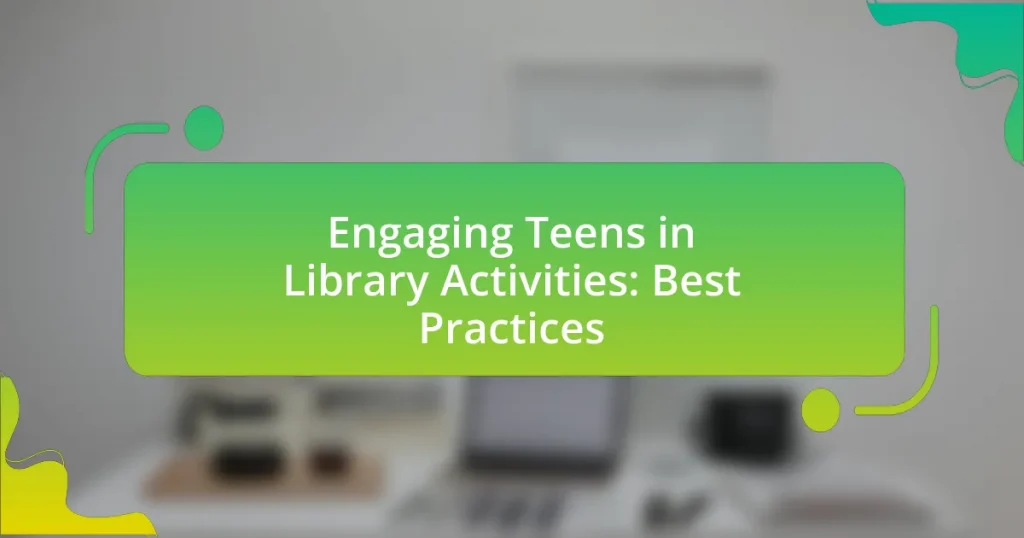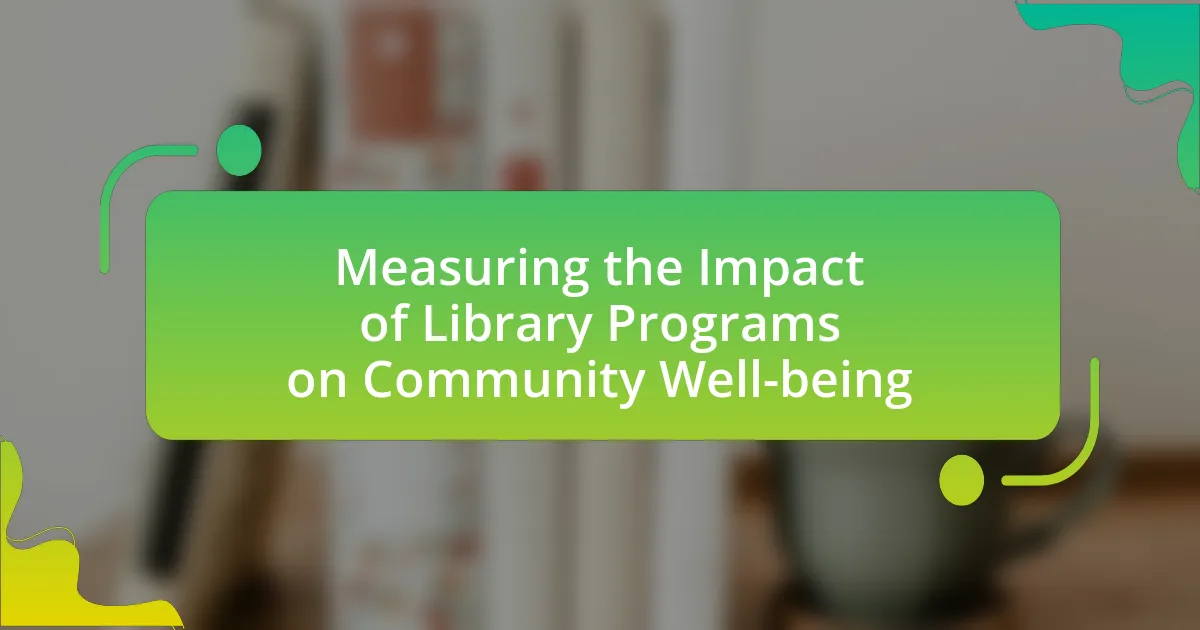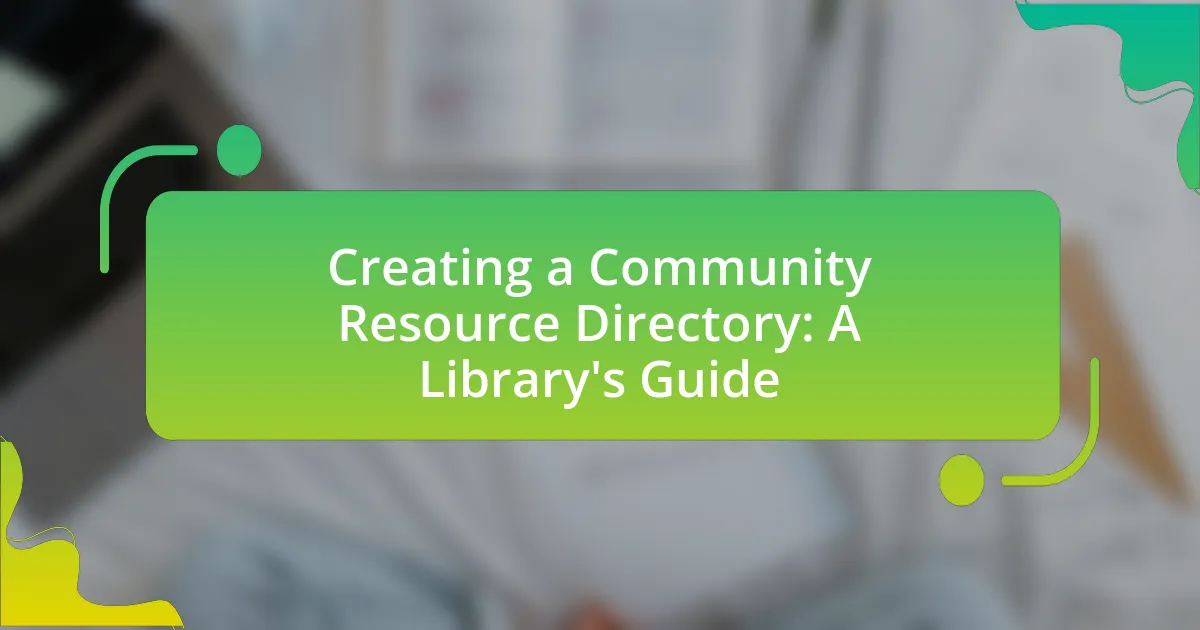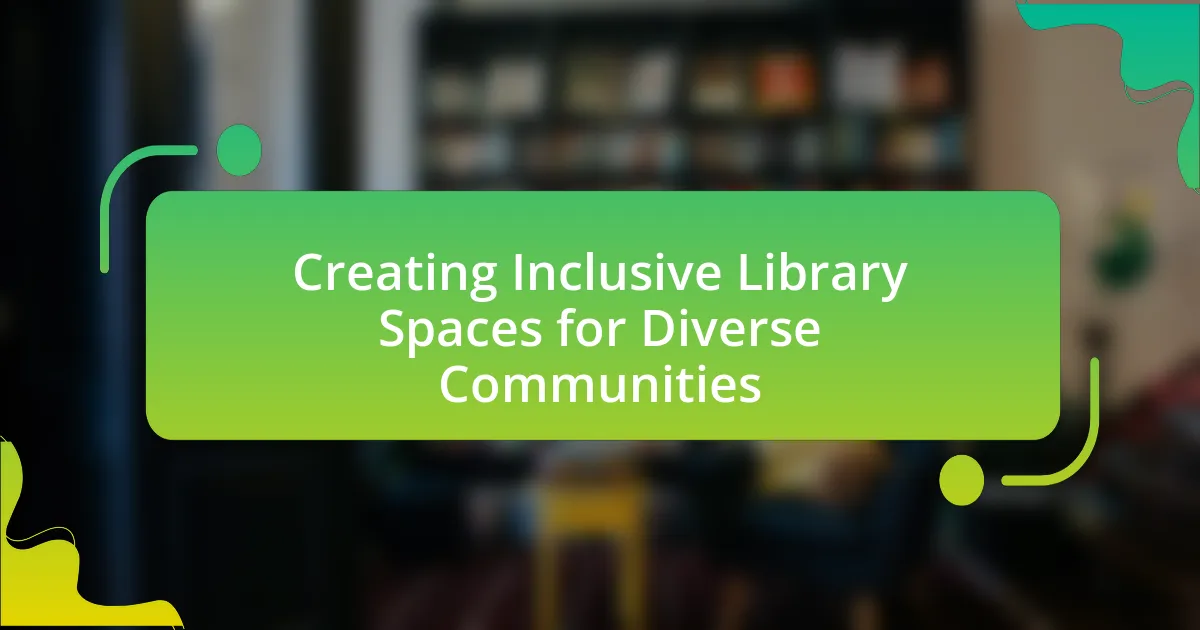The article focuses on effective strategies for engaging teens in library activities, emphasizing the importance of relevant programming, technology utilization, and creating a welcoming environment. Key features of a teen-friendly library include dedicated spaces for collaboration, access to technology, and diverse programming that resonates with adolescents’ interests. The article also discusses the significance of involving teens in the planning process, overcoming barriers to participation, and the role of library staff in fostering engagement. Additionally, it highlights methods for measuring program success and sustaining long-term relationships with teen patrons through partnerships and interactive activities.
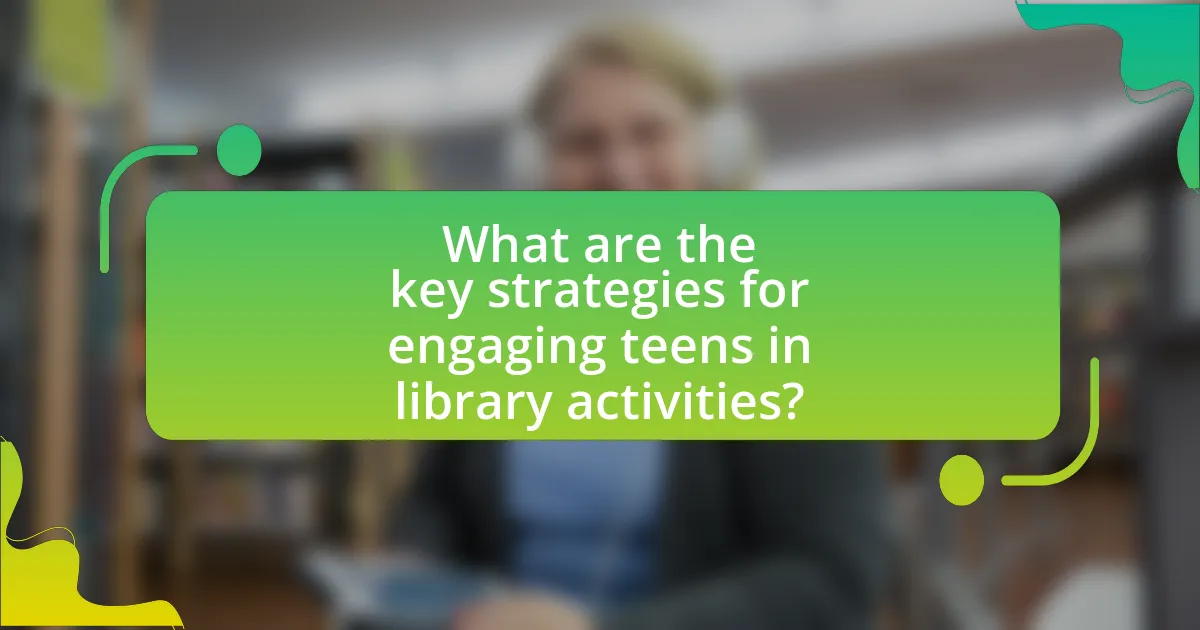
What are the key strategies for engaging teens in library activities?
Key strategies for engaging teens in library activities include offering relevant programming, utilizing technology, and fostering a welcoming environment. Relevant programming, such as book clubs, gaming events, and creative workshops, aligns with teens’ interests and encourages participation. Utilizing technology, like social media and interactive apps, enhances communication and promotes events effectively. Fostering a welcoming environment ensures that teens feel comfortable and valued, which is crucial for sustained engagement. Research indicates that libraries that implement these strategies see increased teen participation and satisfaction, as evidenced by a study from the Young Adult Library Services Association, which highlights the importance of tailored programming and community involvement in attracting young patrons.
How can libraries create a welcoming environment for teens?
Libraries can create a welcoming environment for teens by designing dedicated spaces that cater to their interests and needs. These spaces should include comfortable seating, access to technology, and areas for social interaction, which research shows can enhance engagement and foster a sense of belonging among young patrons. For instance, a study by the American Library Association found that libraries with teen-specific areas reported higher usage rates and positive feedback from adolescents, indicating that tailored environments significantly impact teen participation in library activities.
What specific features should a teen-friendly library have?
A teen-friendly library should have dedicated spaces for collaboration, technology access, and diverse programming. These features cater to the social, educational, and recreational needs of teenagers. Collaborative spaces, such as group study rooms and lounges, encourage teamwork and peer interaction, which are essential for this age group. Access to technology, including computers, tablets, and high-speed internet, supports digital literacy and research skills. Additionally, diverse programming, such as workshops, book clubs, and events tailored to teen interests, fosters engagement and a sense of community. Research indicates that libraries with these features see increased teen participation and satisfaction, highlighting their importance in creating an inviting environment for young patrons.
How does the physical layout impact teen engagement?
The physical layout significantly impacts teen engagement by influencing their comfort, accessibility, and interaction within the space. A well-designed layout that includes flexible seating, collaborative areas, and technology access encourages teens to participate in activities and fosters social interaction. Research indicates that environments that promote movement and socialization, such as open spaces and group seating arrangements, lead to higher levels of engagement among adolescents. For instance, a study by the American Library Association found that libraries with adaptable spaces saw a 30% increase in teen program attendance, demonstrating the direct correlation between physical layout and teen involvement.
What types of activities resonate most with teens?
Teens are most engaged by activities that promote social interaction, creativity, and technology use. Research indicates that group activities such as gaming tournaments, creative workshops, and coding clubs are particularly appealing. For instance, a study by the Pew Research Center found that 72% of teens play video games, highlighting the popularity of gaming as a social activity. Additionally, hands-on creative projects, like art and music workshops, foster self-expression and collaboration, which are crucial for teen engagement.
Which programs are most popular among teenagers?
The most popular programs among teenagers include coding clubs, book clubs, and creative writing workshops. These programs engage teens by fostering skills relevant to their interests and future careers. For instance, coding clubs often attract teenagers due to the increasing demand for technology skills in the job market, while book clubs encourage reading and discussion, enhancing literacy and critical thinking. Creative writing workshops provide an outlet for self-expression, which is crucial during adolescence. According to a survey conducted by the Young Adult Library Services Association, 70% of teens reported enjoying programs that allow them to explore their interests and develop new skills.
How can libraries incorporate technology into activities?
Libraries can incorporate technology into activities by utilizing digital tools such as interactive software, online databases, and social media platforms to enhance engagement. For instance, libraries can host virtual book clubs using video conferencing tools, allowing teens to participate from home, which has been shown to increase attendance and participation rates. Additionally, libraries can implement coding workshops using platforms like Scratch or Minecraft, which not only teach valuable skills but also attract tech-savvy youth. Research indicates that 70% of teens prefer interactive learning experiences, highlighting the effectiveness of technology in fostering engagement in library activities.
Why is it important to involve teens in the planning process?
Involving teens in the planning process is crucial because it fosters a sense of ownership and responsibility among them. When teens participate in planning, they are more likely to engage actively in the activities and programs designed for them, leading to higher attendance and satisfaction rates. Research indicates that youth involvement in decision-making processes enhances their leadership skills and boosts their confidence, which is essential for their personal development. For instance, a study by the National Youth Leadership Council found that youth who are engaged in planning activities demonstrate improved social skills and a greater sense of community belonging.
What methods can libraries use to gather teen input?
Libraries can gather teen input through surveys, focus groups, and suggestion boxes. Surveys allow libraries to collect quantitative data on teen preferences and interests, while focus groups provide qualitative insights through discussions. Suggestion boxes enable teens to anonymously share their ideas and feedback, fostering a sense of ownership and involvement. These methods are effective as they encourage participation and ensure that the voices of teens are heard in library programming and services.
How does teen involvement enhance program effectiveness?
Teen involvement enhances program effectiveness by increasing engagement and participation rates among peers. When teens actively participate in library programs, they contribute unique perspectives and ideas that resonate with their age group, fostering a sense of ownership and relevance. Research indicates that programs with teen input see higher attendance and satisfaction rates, as evidenced by a study from the American Library Association, which found that libraries incorporating teen feedback in program design experienced a 30% increase in participation. This collaborative approach not only improves program quality but also builds essential skills in leadership and teamwork among teens, further amplifying the program’s impact.
What challenges do libraries face in engaging teens?
Libraries face significant challenges in engaging teens, primarily due to competition from digital entertainment and social media. This competition diverts teens’ attention away from traditional library activities, making it difficult for libraries to attract and retain their interest. Additionally, many libraries struggle with limited resources and funding, which restricts their ability to offer programs that resonate with teen interests, such as technology workshops or creative arts initiatives. Research indicates that libraries often lack staff trained in youth engagement strategies, further complicating their efforts to connect with this demographic effectively.
How can libraries overcome barriers to participation?
Libraries can overcome barriers to participation by implementing targeted outreach programs that address the specific needs of diverse communities. For instance, libraries can collaborate with local schools and community organizations to promote events and services tailored to teens, ensuring that information reaches those who may not typically engage with library resources. Research indicates that libraries that actively engage with their communities through social media and local events see increased participation rates; for example, a study by the American Library Association found that libraries with strong community partnerships reported a 30% increase in teen program attendance. By removing logistical barriers, such as transportation issues, and providing flexible programming hours, libraries can further enhance accessibility and encourage greater involvement from teens.
What role do staff play in addressing these challenges?
Staff play a crucial role in addressing challenges related to engaging teens in library activities by facilitating programs that cater to their interests and needs. They design and implement targeted initiatives, such as workshops, events, and outreach activities, that resonate with teenagers, thereby increasing participation. For instance, research indicates that libraries with dedicated youth services staff report higher engagement levels among teens, as these professionals understand the unique preferences and behaviors of this demographic. Additionally, staff members serve as mentors and guides, fostering a welcoming environment that encourages teens to explore library resources and participate in community-building activities.
How can libraries measure the success of their teen programs?
Libraries can measure the success of their teen programs through quantitative metrics such as attendance numbers, program evaluations, and participant feedback. Attendance data provides a clear indicator of interest and engagement, while evaluations can assess the quality and impact of the programs. For instance, a study by the American Library Association found that libraries reporting increased attendance in teen programs also noted higher levels of community engagement and satisfaction. Additionally, collecting qualitative feedback through surveys or focus groups allows libraries to understand the specific needs and preferences of teens, further informing program development.
What metrics should be used to evaluate engagement levels?
To evaluate engagement levels in library activities for teens, key metrics include attendance rates, participation in programs, and feedback scores. Attendance rates measure the number of teens participating in events, indicating interest and reach. Participation in programs assesses how actively teens engage in various activities, reflecting the effectiveness of those programs. Feedback scores, gathered through surveys or evaluations, provide insights into teens’ satisfaction and perceived value of the activities. These metrics collectively offer a comprehensive view of engagement levels, enabling libraries to adjust their strategies effectively.
How can feedback from teens inform future activities?
Feedback from teens can inform future activities by providing insights into their interests, preferences, and needs. This information allows libraries to tailor programs that resonate with the teen demographic, ensuring higher engagement and participation. For instance, a study by the Young Adult Library Services Association (YALSA) found that when libraries actively sought input from teens, they were able to increase attendance at events by 30% by aligning offerings with teen interests. By analyzing feedback through surveys or focus groups, libraries can identify popular themes, preferred formats, and desired outcomes, leading to more effective programming that meets the evolving expectations of young patrons.
What are some best practices for sustaining teen engagement in libraries?
To sustain teen engagement in libraries, implementing interactive programs that align with their interests is essential. Libraries should offer diverse activities such as gaming nights, book clubs, and creative workshops that cater to various hobbies and preferences. Research indicates that when teens participate in programs that resonate with their passions, they are more likely to return and engage consistently. For instance, a study by the American Library Association found that libraries that host regular events tailored to teen interests see a 30% increase in attendance over time. Additionally, fostering a welcoming environment where teens feel safe and valued encourages ongoing participation.
How can libraries build long-term relationships with teens?
Libraries can build long-term relationships with teens by creating engaging, relevant programs that cater to their interests and needs. By offering activities such as book clubs, gaming events, and creative workshops, libraries can foster a sense of community and belonging among teens. Research indicates that 70% of teens prefer spaces where they can socialize and collaborate, highlighting the importance of interactive programming. Additionally, libraries can utilize social media platforms to communicate directly with teens, gather feedback, and promote events, ensuring that their offerings remain aligned with teen preferences. This approach not only enhances engagement but also encourages teens to view the library as a supportive and integral part of their lives.
What role do partnerships with schools and community organizations play?
Partnerships with schools and community organizations play a crucial role in enhancing library activities for teens. These collaborations facilitate access to resources, promote literacy, and create a supportive environment for youth engagement. For instance, research indicates that libraries that partner with schools can increase student participation in library programs by up to 30%, as they provide tailored programming that aligns with educational curricula. Additionally, community organizations can offer diverse perspectives and resources, enriching the library’s offerings and making them more relevant to the interests of teens.
What practical tips can libraries implement to enhance teen engagement?
Libraries can enhance teen engagement by offering interactive programs that cater to their interests, such as gaming nights, creative workshops, and book clubs focused on popular genres. These activities not only attract teens but also foster a sense of community and belonging. Research indicates that libraries that implement such programs see increased attendance and participation rates among teens, as evidenced by a study from the American Library Association, which found that 70% of teens reported feeling more connected to their library when they participated in engaging activities.
